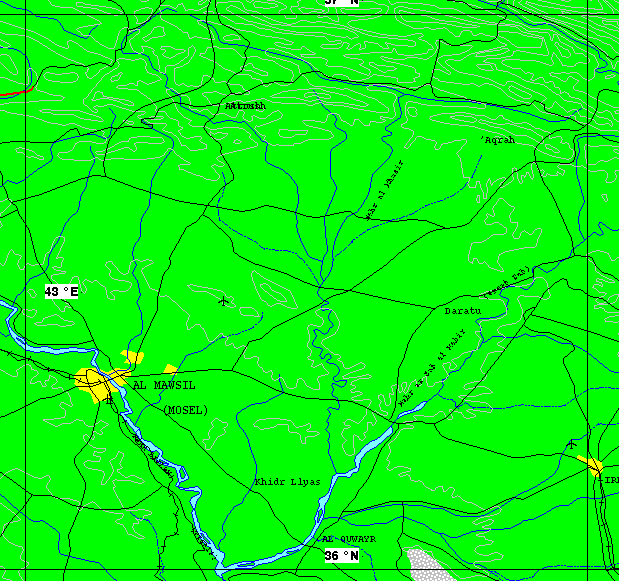Mosul

Mosul is the reported location of the Jaber bin Hayan General Establishment, producing UF6 for the production of Uranium 235 for nuclear weapons. It is also the location of the Al Kindi General Establishment, which according to some reports has engaged in production of UCl4 for the production of Uranium 235 for nuclear weapons.
Al Jesira Factory was a Uranium feed stock production facility. Iraq built facilities to produce uranium oxide and uranium tetrachloride feedstocks. The facility is located 385 km NW of Baghdad near Mosul [which may or may not be near the region of Al Jazirah 35°10'N 42°00'E, which seems a bit distant to be "near Mosul"]. The undeclared uranium conversion plant in Jesira, capable of producing UO2 from yellowcake and UCl4 from UO2 should have been declared and, consequently, should have been subject to IAEA safeguards. Iraq conducted extensive deception to hide the true nature of the chemical plant.
The facility was planned to be the site of future production facility for uranium hexafluoride. Products included: uranium dioxide, uranium tetrachloride, and uranium hexaflouride. Facility 212 processes U2O8 and U3O8 into UO2. The raw U2O8 and U3O8 is a by-product of al-Akarhat fertilizer plant, not itself part of the Iraqi nuclear program. Facility 244, which is adjacent to 212, processed the UO2 from facility 212 into uranium tetrachloride (UCl4).
The facility was attacked during the Gulf War. The critical areas of the 212 Facility were not damaged during the Gulf War, while Facility 244 suffered no more than 20% aggregate damage.
-------------------------------------------------------
Sa'ad General Establishment, Mosul
Saad 16, located at Mosul near the Tigris River, was the biggest missile development site in Iraq. It was the primary Condor II missile development center, with additional research conducted on chemical and nuclear weapons. Missile research facilities include launch range, high-speed wind tunnels, missile test facilities, and chemical and electronics laboratories. An aircraft production facility was planned nearby. Among the projects at Saad 16 was a nuclear weapon construction effort.
As early as 1986, the Pentagon had intelligence information linking Sa'ad 16 to missile work, as well as other weapons of mass-destruction. The earliest detailed accounts of Sa'ad 16 in the open press,emerged in January 1989, when the German magazine Stern published a list of the Sa'ad 16 laboratories. At least 78 laboratories were located at Sa’ad 16, including four for testing engine starting material and fuel mixtures, two for calometric testing of fuels, two for developing control systems and navigation equipment and one for measuring aerodynamic quantities on models.
The Al Kindi Research Complex, formerly known as Saad 16 or the Sa'ad General Establishment, was a part of the State Organization for Technical Industries (SOTI), a part of the Iraqi Ministry of Defense. Another name for Sa'ad 16 was the "Research and Development Center." Al Kindi was one of the largest and most secret armament project in Iraq. The facilities constructed on the northern rim of the town on the Tigris River are located in a valley 1 km off the transit road to Sachu . The facility was guarded with electronics and video cameras by the military. The more than 3.3-km-long fence was equipped with watchtowers, and the main entrance was equipped with quick-action barriers. An independent energy supply provided power to the facility, which features extensive camouflage.
The facility's is a 100-meter-long hall for the construction of prototypes. In the northern part of the area a 120-meter-long subterranean shooting gallery -- 4 meters wide and 4 meters high -- was tunneled into the mountain. The walls were insulated with noise-proof naps. In a side valley to the west, there were 28 "resistance buildings," with stable roofs that are slanted down on one side and three stable walls. The fourth wall is made only of wood so that in case of laboratory accidents, the pressure of an explosion is purposefully directed into a harmless direction. Most of the 58 chemical laboratories were located there.
Adjacent, protected by walls on all sides, there was a missile test stand with control rooms and climate chambers. The buildings with measuring laboratories, which are close by, are also protected by a 150-meter-long wall against the chemical laboratories.
As many as 38 German companies provided a comprehensive training program for Iraqi experts, who were trained in operating chemical laboratories and electronics workshops, wind tunnels, and physical test facilities. Gildemeister Projects GmbH (Gipro) of Germany was a major contractor for the Saad 16 project, and by some estimates US companies supplied 40 percent of the high-technology equipment for the Saad 16 project.